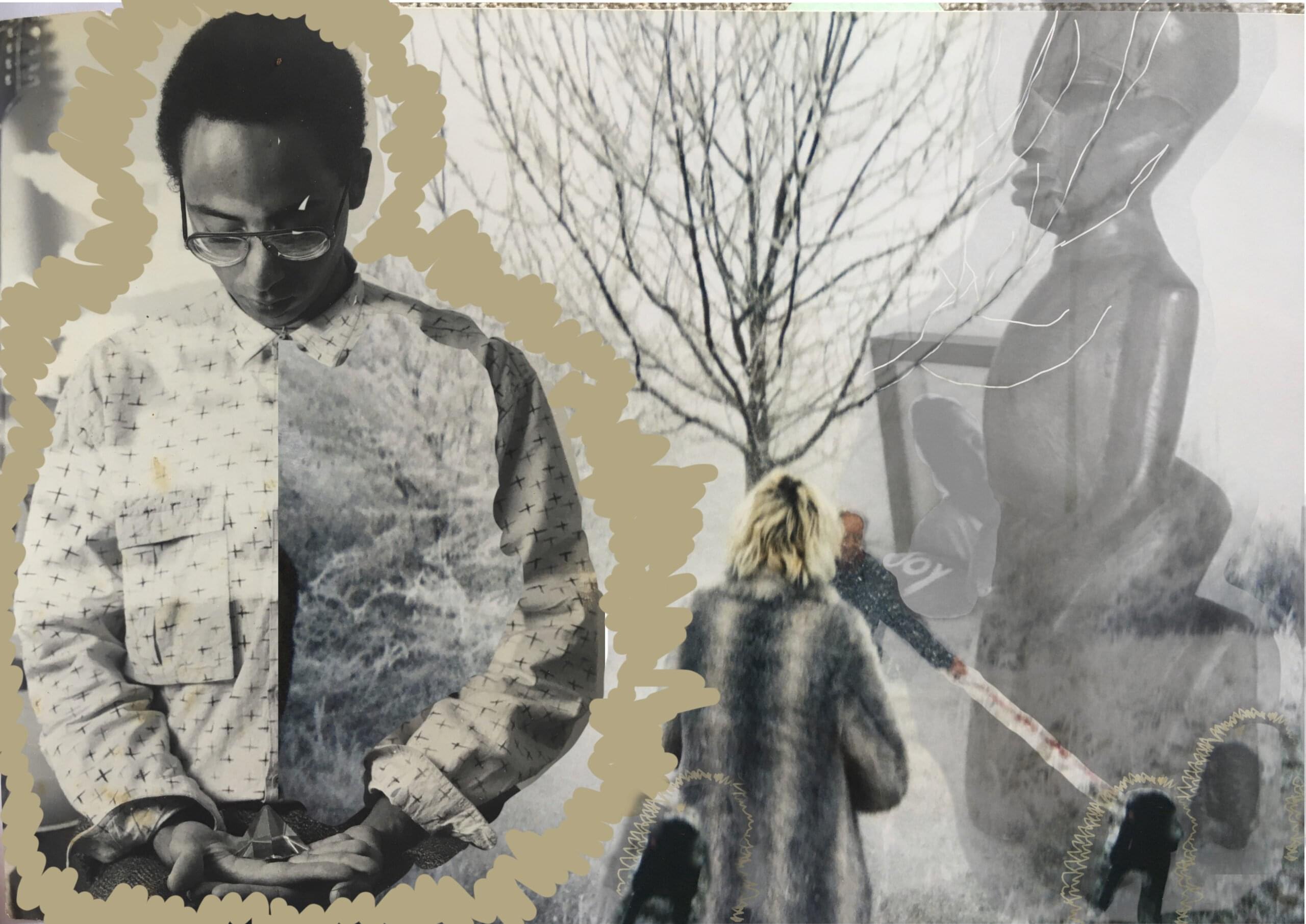The centrepiece of the online page for Alice Rekab’s multi-platform Family Lines Project at the Douglas Hyde Gallery is a composite artwork that combines images of individuals with trees, animals, traditional African sculpture, and digital drawings. Its most prominent feature is a photograph of a young woman who observes a diamond in her palms, bordered by digitally-created beams. Her posture is poignant in light of the artwork’s neighbouring image – that of a page from a book that details diamond smuggling in Sierra Leone, a destructive practice in which Western markets are complicit – whilst the digital beams replicate what Rekab has deemed an act of “honour” or making “shine”. Similarly multifaceted, the collaged trees are wintry and bare, indicating both decline and the potential for renewal. These complexities bespeak Rekab’s continual concern with the “expressions and iterations of complex cultural and personal narratives” and are characteristic of the Family Lines exhibition as it spans platforms, artists, and forms of dialogue alike.
The project aims to voice the generational experiences of Black and mixed-race individuals in Ireland, focusing particularly on stories of migration and survival within family units. It was developed in collaboration with Éireann and I, a community archive for Black migrants that works against traditional archival institutions, to both shape and faithfully represent the collective memories of marginalised communities. The exhibition takes various forms – currently online, it will be presented in the Gallery this coming summer and is complemented by a collection of public billboards. It allows for engagement, conversation, and collaboration through its series of participatory workshops, its inclusion of other artists’ work, and the dialogues that supplement these additions. This expansiveness indicates the recognition that ideation and understanding are often processual and collaborative, inviting us to assume a more reciprocative role than that of the passive observer imposed in more traditional gallery settings.
“The films are a combination of contemporary and late twentieth century issues that affect Black and mixed-race individuals alongside those that are more particular to the present day.”
A significant part of the project is its online film screenings. Having begun last September, these will continue monthly until July. The films are a combination of contemporary and late twentieth century issues that affect Black and mixed-race individuals alongside those that are more specific to the present day. There is considerable stylistic variance across the films. December’s screening, The names have changed, including my own and truths have been altered by Onyeka Igwe, is an eclectic piece, attempting to voice “a truth in as many ways as possible”. The film narrates stories of African diasporic life to push against the dominance of colonial history, with Igwe explicitly noting the incongruity between the traditional archives and her own family history. Other screenings have included films from the Black Audio Film Collective, Martina Attille, and Ufuoma Essi.
“This month features The Expulsion by Larry Achiampong, a film inspired by the director’s childhood experiences of attending work with his mother; a cleaner who took on night shifts in central London.”
This month features The Expulsion by Larry Achiampong, a film inspired by the director’s childhood experiences of attending work with his mother, a cleaner who took on night shifts in central London. The piece addresses the lived experiences of the migrants whose significance goes unrecognised by wider society – those individuals who “wipe the boardrooms on which you dictate our futures,” and yet are treated worse than their white working-class counterparts. Achiampong compellingly combines naturalistic images of a cleaner as she works alone in an office space – highlighting the physical labour of her hands as she sweeps, wipes, and throws away – with a voiceover that elucidates her experiences through poeticised passages, often emphasised by vocal distortion. In the film’s introductory soundpiece, he explains that this lack of recognition is a purposeful move by those in power, and that unacknowledged and undocumented individuals are actually desired for the kinds of menial labour that allow societies to function. For Achiampong, this unfairness constitutes a personal trauma, and he relates the experiences described in his film to those shown in next month’s screening of Jennifer Martin’s TEETH, a fictional depiction of an interracial couple interrogated by UK Home Office.
“Through its accessibility and potential for engagement, the project provides us with an important opportunity for conversation, relation, and reeducation; it unpicks the archive’s histories and weaves them anew. “
In their written accompaniment to Attille’s film Dreaming Rivers, Rekab describes learning their family story as a child: “I carried a photo, who we were and where we came from. I taught people how to say our surname. These were fragments of lives remembered, and retold, woven together to make some kind of sense to anyone who asked the question ‘where are you from?’” This phrase encapsulates the heart of Family Lines, privileging the personal experiences of minority groups in Ireland and uniting of them in a multi-form exhibition by means of their common thread, their mis- and underrepresentation. Through its accessibility and potential for engagement, the project provides us with an important opportunity for conversation, relation, and reeducation; it unpicks the archive’s histories and weaves them anew.






